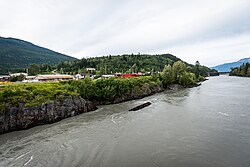| Nass River | |
|---|---|
 View west on Nass River at Gitwinksihlkw | |
 Location map of the Nass River | |
| Location | |
| Country | Canada |
| Province | British Columbia |
| Districts | Cassiar Land District Range 5 Coast Land District |
| Physical characteristics | |
| Source | Nass Lake[1] |
| • location | Klappan Range, Skeena Mountains |
| • coordinates | 57°9′59″N 129°6′8″W / 57.16639°N 129.10222°W[1] |
| • elevation | 1,058 m (3,471 ft)[2] |
| Mouth | Nass Bay |
• location | Portland Inlet |
• coordinates | 54°58′37″N 129°53′22″W / 54.97694°N 129.88944°W[3] |
| Length | 380 km (240 mi)[4] |
| Basin size | 20,839 km2 (8,046 sq mi)[5] |
| Discharge | |
| • location | Mouth[6] |
| • average | 770 m3/s (27,000 cu ft/s) |
The Nass River is a river in northern British Columbia, Canada. It flows 380 km (240 mi) from the Coast Mountains southwest to Nass Bay, a sidewater of Portland Inlet, which connects to the North Pacific Ocean via the Dixon Entrance. Nass Bay joins Portland Inlet just south of Observatory Inlet.[7][8]
The English name "Nass" is derived from the Tlingit name Naas which means "intestines" or "guts" in reference to the river's large food capacity in its fish (Naish & Story 1963; Leer, Hitch, & Ritter 2001). Can also be a Tlingit word for "food depot". Former spellings are Naas and Nasse.[9] The Nisga'a name for the river is K'alii Aksim Lisims "Lisims (river name) Valley". The Gitxsan name is Git-Txaemsim meaning People of Txeemsim (Raven or Trickster); Xsitxemsem in the dialect of the Gitanyow). Lisims means "murky" in Nisga'a, referring to the river's silt-laden flow.[3]
The last 40 km (25 mi) of the river are navigable. The river is a commercially valuable salmon fishery. The basin of the Nass is the location of the first modern-day treaty settlement in British Columbia, between the government of that province and the Nisga'a Nation. The name Nisga'a is a reduced form of [naːsqaʔ], which is a loan from Tongass Tlingit, where it means "people of the Nass River".[10][better source needed]
On the term:
Archdeacon W. H. Collison, an authority on this subject, and who has resided at Kincolith, Nass bay, since 1883, states as follows: - "The term Nass is from the Tlingit tongue, and when, as was probable, the Tlingits from Tongass, at the entrance to Observatory inlet, met Captain Vancouver they gave him their name for the river, i.e., Nass, which means literally "the stomach," from the fact that their food supplies of salmon, oolachan.. a noted fishery."[11]
- ^ a b "Nass Lake". BC Geographical Names.
- ^ Elevation derived from ASTER Global Digital Elevation Model, using GeoLocator, and BCGNIS coordinates.
- ^ a b "Nass River". BC Geographical Names.
- ^ Nass River Archived 2005-05-07 at the Wayback Machine, The Columbia Gazetteer of North America
- ^ Gazetteer of Canada. Vol. British Columbia. Canadian Board on Geographic Names. 1953. p. xv.
- ^ Normal Runoff from British Columbia, Ministry of Environment, Water Stewardship Division
- ^ "Bay Point". BC Geographical Names.
- ^ "Nass Point". BC Geographical Names.
- ^ Hamilton, William (1978). The Macmillan Book of Canadian Place Names. Toronto: Macmillan. p. 46. ISBN 0-7715-9754-1.
- ^ Rigsby, Bruce "Nisga'a Etymology", ms. University of Queensland.
- ^ Walbran, John T. (1909). British Columbia Coast Names, 1592-1906, to which are Added a Few Names in Adjacent United States Territory: Their Origin and History. Government printing bureau. p. 352.